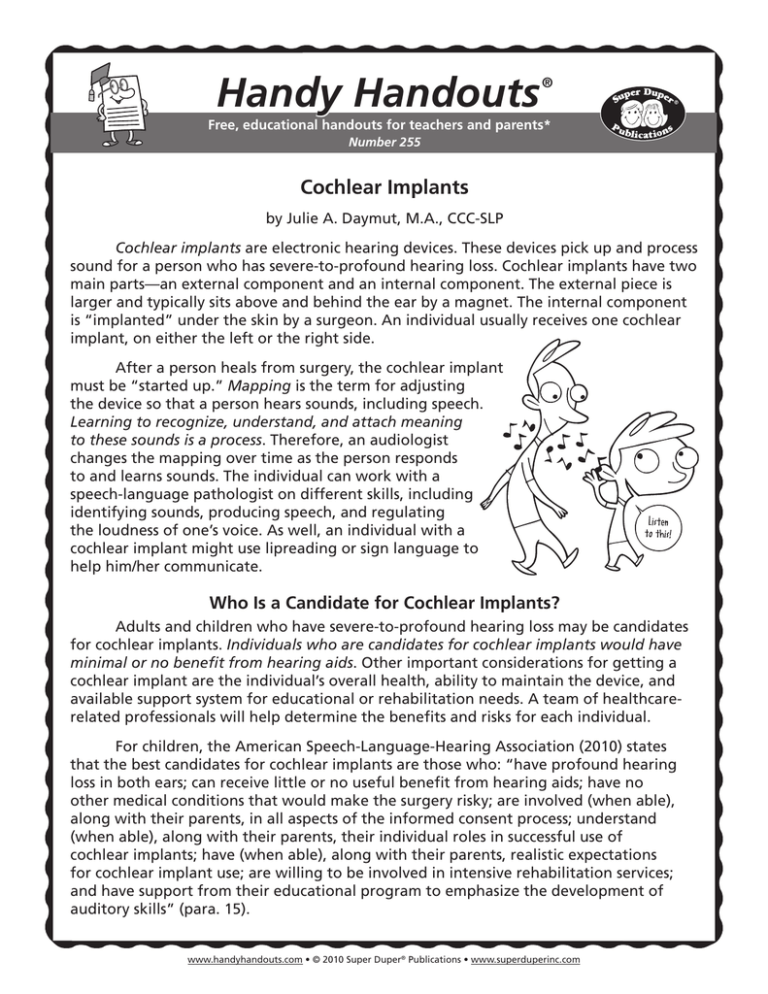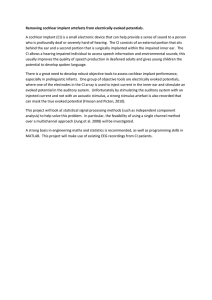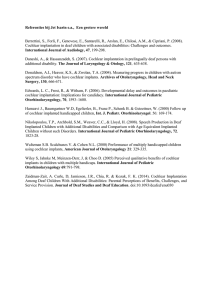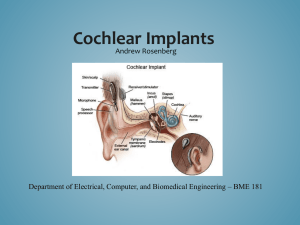Handy Handouts Cochlear Implants
advertisement

Handy Handouts ® Free, educational handouts for teachers and parents* Number 255 Cochlear Implants by Julie A. Daymut, M.A., CCC-SLP Cochlear implants are electronic hearing devices. These devices pick up and process sound for a person who has severe-to-profound hearing loss. Cochlear implants have two main parts—an external component and an internal component. The external piece is larger and typically sits above and behind the ear by a magnet. The internal component is “implanted” under the skin by a surgeon. An individual usually receives one cochlear implant, on either the left or the right side. After a person heals from surgery, the cochlear implant must be “started up.” Mapping is the term for adjusting the device so that a person hears sounds, including speech. Learning to recognize, understand, and attach meaning to these sounds is a process. Therefore, an audiologist changes the mapping over time as the person responds to and learns sounds. The individual can work with a speech-language pathologist on different skills, including identifying sounds, producing speech, and regulating the loudness of one’s voice. As well, an individual with a cochlear implant might use lipreading or sign language to help him/her communicate. Who Is a Candidate for Cochlear Implants? Adults and children who have severe-to-profound hearing loss may be candidates for cochlear implants. Individuals who are candidates for cochlear implants would have minimal or no benefit from hearing aids. Other important considerations for getting a cochlear implant are the individual’s overall health, ability to maintain the device, and available support system for educational or rehabilitation needs. A team of healthcarerelated professionals will help determine the benefits and risks for each individual. For children, the American Speech-Language-Hearing Association (2010) states that the best candidates for cochlear implants are those who: “have profound hearing loss in both ears; can receive little or no useful benefit from hearing aids; have no other medical conditions that would make the surgery risky; are involved (when able), along with their parents, in all aspects of the informed consent process; understand (when able), along with their parents, their individual roles in successful use of cochlear implants; have (when able), along with their parents, realistic expectations for cochlear implant use; are willing to be involved in intensive rehabilitation services; and have support from their educational program to emphasize the development of auditory (para. 15). www.handyhandouts.com • © 2010 Super Duper® Publications • www.superduperinc.com For more information on cochlear implants go to: FDA U.S. Food and Drug Administration – Medical Devices – Cochlear Implants http://www.fda.gov/MedicalDevices/ProductsandMedicalProcedures/ ImplantsandProsthetics/CochlearImplants/default.htm National Institute on Deafness and Other Communication Disorders – Cochlear Implants http://www.nidcd.nih.gov/health/hearing/coch.asp Resource American Speech-Language-Hearing Association. (2010). Cochlear implants. Retrieved from http://www.asha.org/public/ hearing/treatment/cochlear_implant.htm For more Handy Handouts®, go to www.handyhandouts.com. Helpful Products The list of Super Duper® products below may be helpful when working with children who have special needs. Visit www.superduperinc.com and type in the item name or number in our search engine. Click the links below to see the product description. Auditory Discrimination and Lip Reading Skills Inventory™ (ADLR™) Item #ADLR-26 Cochlear Implant Auditory Training Guide with CDs Item #WPB-234 Sign Language Bingo Item #BGO-133 400 Webber® Sign Language Cards Item #WSL-100 *Handy Handouts® are for classroom and personal use only. Any commercial use is strictly prohibited. www.handyhandouts.com • © 2010 Super Duper® Publications • www.superduperinc.com




